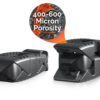Silicon Nitride Material for Spinal Implants
Admin ยท November 29, 2019

Silicon Nitride (Si3N4) has become an increasingly growing new biomaterial for spinal devices and implants. Silicon nitride is an inorganic compound made of silicon and nitrogen and is commonly found in a ceramic form. CTL Amedica has become a leader in developing silicon nitride material for spinal implants. The use of silicon nitride can be used as an alternative to materials like PEEK (polyether ether ketone) and titanium.
Current Uses of Silicon Nitride
The use of silicon nitride is found in various industries, including but not limited to, the medical, automobile, electrical, and aerospace industries. In addition in spinal implants, silicon nitride has also been used in other medical device applications, including screws, plates, and other orthopedic implants such as hip and knee implants. The overall silicon nitride market is projected to grow to $127 million by 2023 [1]. In the medical device industry, silicon nitride is expected to see an increase in use for spinal implants.
Properties of Silicon Nitride
Studies have been conducted to understand silicon nitride as bioactive material. Silicon nitride has been found to be highly compatible with X-ray, MRI, and CT imaging modalities, as the material is non-magnetic. Silicon nitride has been found to have property strengths including high strength, toughness, and wear resistance. Other favorable properties include stability, wettability, favorable pH, visible nanostructures, and long term durability. Silicon nitride is also resistant to bacteria and shows an affinity to bone growth, due to the molecular and atomic levels of the surface of silicon nitride. The FDA has previously given clearance to implants using silicon nitride following various ISO and ASTM standards. With over 35,000 silicon nitride implants in patients, no risk or adverse events involving silicon nitride implants have been reported in regard to the use of material. No clinical data has been proven to show cytotoxicity and cargoncencity through extensive studies, including a low infection risk in comparison to other materials.
Properties of Silicon Nitride Applied to Medicine
The longevity of silicon nitride with no reported adverse events has been shown through the 2018 publication of a 30-year study. The study, “Anterior Lumbar Interbody Fusion Using Reaction Bonded Silicon Nitride Implants: Long-Term Case Series of the First Synthetic Anterior Lumbar Interbody Fusion Spacer Implanted in Humans,” followed the clinical results of lumbar fusion surgeries using silicon nitride implants. The overall conclusion from the study was the confirmation of silicon nitride being a long- term biocompatible material, with the ability for radiologic osseointegration.
Possible Future Uses of Silicon Nitride
The use of silicon nitride as a surface coating is also being studied. The use of etching or lasering silicon nitride onto other materials, for example, PEEK or titanium, can allow the material and mechanical properties of the base material to remain, as well as enhance the optimal properties of the silicon nitride. Studies on creating porous silicon nitride and the effects of silicon nitride over porous titanium using 3d printing are currently being undergone.
Comparing Silicon Nitride
In comparison to PEEK or titanium, common materials used in medical devices, silicon nitride is naturally a bioactive material. PEEK is a bioinert material, while titanium can be made into a bioactive material with a titanium oxide layer. However, there is limited bioactivity and does not show up on X-rays or MRI’s. 3D-printing these materials does not add any bioactivity.
Dr. Sonny Bal, Chief Executive Officer and President of Sintx Technologies, Inc., stated, “Rather than use engineering gimmicks to make materials what they are not, this one [silicon nitride] is already there.”
Projections
Silicon nitride is projected to grow in its use for spinal and orthopedic implants. With strong material properties, imaging compatibility, and biocompatibility proven, silicon nitride is rising as a potentially ideal biomaterial. What are your thoughts on silicon nitride for medical implants?
Sources of Information
[1]Medical Applications to Drive Silicon Nitride Market through 2023, 2019, Ceramic Industries
https://www.ceramicindustry.com/articles/97825-medical-applications-to-drive-silicon-nitride-market-through-2023
[2]CTL Medical to Become World’s Only Provider of Silicon Nitride Spine Products, 2018, SPINEMarketGroup
http://www.thespinemarketgroup.com/ctl-medical-to-become-worlds-only-provider-of-silicon-nitride-spine-products/
[3]Ralph J. Mobbs, Prashanth J. Rao, Kevin Phan, Philip Hardcastle, Wen Jie Choy, Eric R. McCartney, Ross K. Druitt, Christopher A.L. Mouatt, Charles C. Sorrell, Anterior Lumbar Interbody Fusion Using Reaction Bonded Silicon Nitride Implants: Long-Term Case Series of the First Synthetic Anterior Lumbar Interbody Fusion Spacer Implanted in Humans, World Neurosurgery, Volume 120, 2018, Pages 256-264, ISSN 1878-8750,
https://doi.org/10.1016/j.wneu.2018.08.237
[4]Interview with Dr. Sonny Bal, conducted by Meghna Negi








